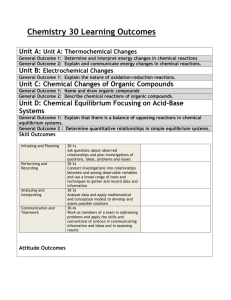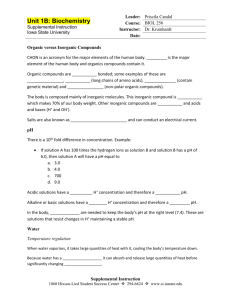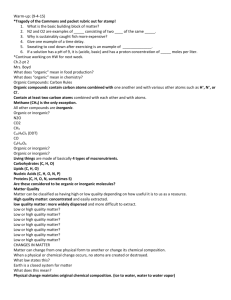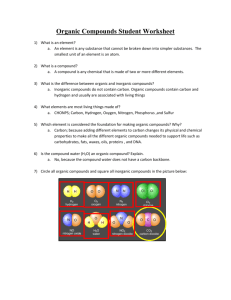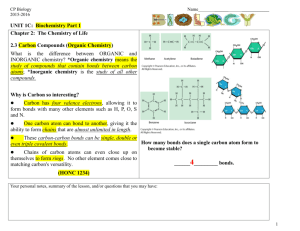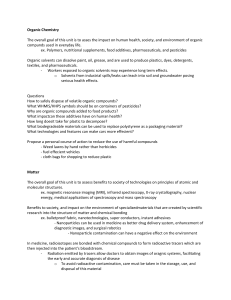SYLABUS
advertisement
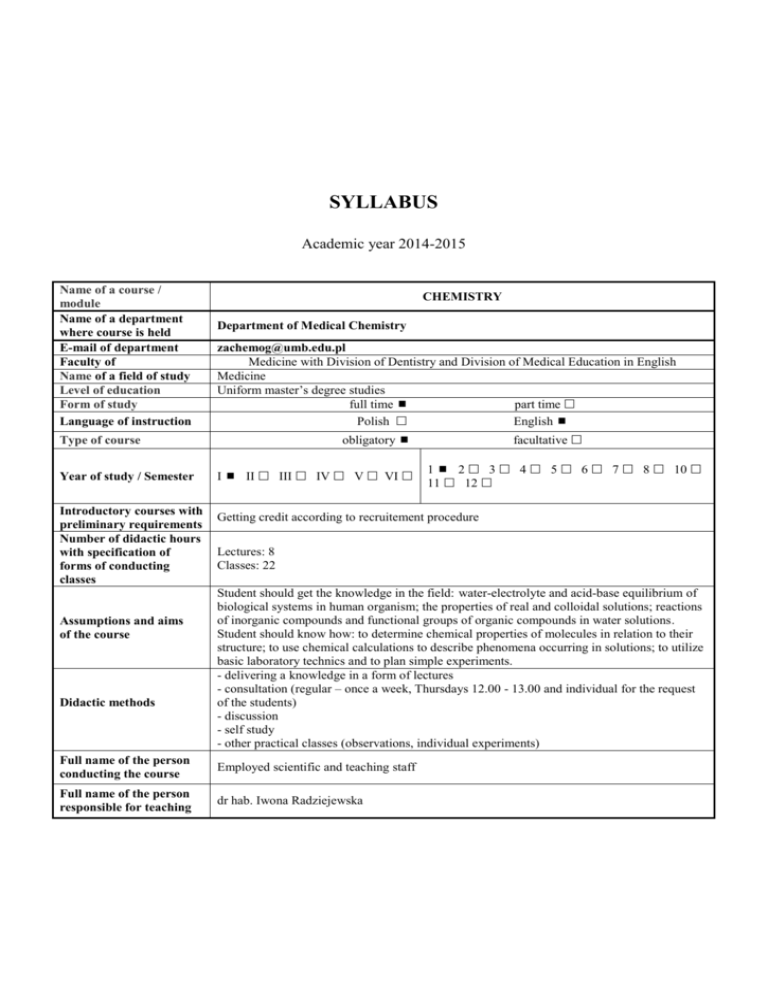
SYLLABUS Academic year 2014-2015 Name of a course / module Name of a department where course is held E-mail of department Faculty of Name of a field of study Level of education Form of study Language of instruction CHEMISTRY Department of Medical Chemistry zachemog@umb.edu.pl Medicine with Division of Dentistry and Division of Medical Education in English Medicine Uniform master’s degree studies full time part time Polish English obligatory Type of course Year of study / Semester Introductory courses with preliminary requirements Number of didactic hours with specification of forms of conducting classes Assumptions and aims of the course Didactic methods I II III IV V VI facultative 1 2 3 4 5 6 7 8 10 11 12 Getting credit according to recruitement procedure Lectures: 8 Classes: 22 Student should get the knowledge in the field: water-electrolyte and acid-base equilibrium of biological systems in human organism; the properties of real and colloidal solutions; reactions of inorganic compounds and functional groups of organic compounds in water solutions. Student should know how: to determine chemical properties of molecules in relation to their structure; to use chemical calculations to describe phenomena occurring in solutions; to utilize basic laboratory technics and to plan simple experiments. - delivering a knowledge in a form of lectures - consultation (regular – once a week, Thursdays 12.00 - 13.00 and individual for the request of the students) - discussion - self study - other practical classes (observations, individual experiments) Full name of the person conducting the course Employed scientific and teaching staff Full name of the person responsible for teaching dr hab. Iwona Radziejewska Symbol and number of learning outcomes according to the teaching standards and other learning outcomes Description of directional learning outcomes Knowledge knows how to describe water-electrolyte equilibrium of biological systems knows how to describe acid-base equilibrium, buffer action mechanism and its significance for systemic homeostasis knows such terms as solubility, osmotic pressure, isotonia, colloidal solution and Gibbs-Donnan equilibrium B.W1 B.W2 B.W3 knows basic inorganic and organic compound reactions in aqueous solution B.W4 Skills calculating molar and percentage concentration of the compounds as well as concentration of substances in single- and multi-component isotonic solutions defining pH of the solution and impact of pH modification on organic and inorganic compounds B.U3 B.U5 using fundamental laboratory techniques, such as qualitative analysis, titration, pH-metry, B.U9 Social competence be aware of his/her own limitations and need to improve their skills continually K1 can work in a team of professionals, in multicultural and multiethnic environment K2 Form of classes Verification methods for achieving intended learning outcomes lectures classes Summarizing methods:, - written final test lectures classes lectures classes Forming methods: - observation of the student's work - evaluation of the activity in the classroom - assessment of preparation for classes - discussion in class - partial tests classes Summarizing methods: - realization of a specific task lectures classes classes classes classes classes Forming methods: - observation of the student's work - evaluation of the activity in the classroom - completion of each activity - discussion in class - partial tests Summarizing methods: Continuous assessment by teachers (observation) Forming methods: - observation of the student's work - discussion in class - opinions of colleagues ECTS points Student Workload 1. 2. 3. 4. 5. 1. 2. 3. Form of activity Number of hours to complete the activity Classes that require the participation of a teacher Realization of the course: lectures (according to the curriculum ) 8 Realization of the course: classes (according to the curriculum ) 22 Realization of the course: seminars; (according to the curriculum) Realization of the course: electives Participation in consultation Total hours: 30 Student self-study Preparation for the theoretical and practical classes (realization of 15 projects, documentation, case description etc.) Preparation for tests/credits Preparation for an exam/final test-credit 10 Total hours: 55 Course contents: Learning outcomes (symbol and number) Topics Lectures: 1. B.W1 - describe water-electrolyte equilibrium of biological systems 2. B.W2 - describe acid-base equilibrium, buffer action mechanism and its significance for systemic homeostasis Properties of water and its biological importance. Main ions of body fluids. Buffer mixtures – a mechanism of pH stabilization, buffer capacity. A role of physiological buffers in maintaining of a stable pH of physiological fluids. Alkacymetry as an example of titration analysis – alkacymetric indicators, titration curves. 3. B.W3 - knows such terms as solubility, osmotic pressure, isotonia, colloidal solution and Gibbs-Donnan equilibrium Solutions – types of solutions, solubility, types of expression of solution concentration. Colloidal solutions. Lyophobic and lyophilic colloids. Colligative properties of solutions. Diffusion and osmosis, osmotic and oncotic pressure. GibbsDonnan equilibrium. 4. B.W4 - knows basic inorganic and organic compound reactions in aqueous solution Simple organic compounds and their derivatives with biological importance – carboxylic acids, aromatic hydrocarbons and their derivatives in vitamins and hormones, selected heterocyclic compounds in vitamins and drugs. Oxygen free radicals - formation and structure, harmful effect on proteins, unsaturated fatty acids and DNA. Defensive mechanisms of human body. Classes: 5. B. W4 - knows basic inorganic and organic compound reactions in aqueous solution Characteristic reactions of biologically important ions. Determination of functional groups in organic compounds (multiple bonds, alcohols and phenols, aldehydes, carboxylic acids, ketones, amines). 6. B.U3 - calculating molar and percentage concentration of the compounds as well as concentration of substances in single- and multi-component isotonic solutions Solutions and their properties – preparation of solutions with specific molar and percent concentrations, converting of concentrations; lyophilic and lyophobic colloids preparations, examination of protective properties of lyophilic colloids; comparing of osmotic pressure of colloidal and real solutions 7. B.U5 - defining pH of the solution and impact of pH modification on organic and inorganic compounds Buffer solutions – buffers preparations and their pH determination using indicators and pH-meter. Determination of the influence of buffer dilution on pH and buffer capacity. Assigning of dissociation degree and dissociation constant of electrolytes. 8. B.U9 - using fundamental laboratory techniques, such as qualitative analysis, titration, pH-metry Alkacymetry as an example of titration analysis – quantitative determination of weak and strong acid. Obligatory textbook: 1. Timberlake K. C. “General, organic and biological chemistry” Optional textbook: 2. Bresnick S. “High-yield general chemistry” Criteria for assessing the achieved learning outcomes and the form and conditions for receiving credit: Students are obliged to attend all classes. Absences should be excused as soon as possible. In case of illness, a doctor’s leave should be presented; any other absences should be confirmed by the dean or proper authorities. Excused absences should be make up in a fixed time. The consequence of unexcused absences (more than one) is lack for credit at Chemistry. To get credit of the whole course students should pass all the classes and a written final test. The condition to get credit from classes and to be admitted to the final test is obtaining 28 points. In case of less than 28 points, students may not get credit at Chemistry. The conditions of passing the class: a) performing experiments with showing an understanding of a sense of carried procedures; b) credit from a written partial class test. During classes students can get the following number of points: ● oral answer 2 points ● written partial class test 9 points ● performing experiments 3 points ________________________________________________________________ maximum possible number of points 14 points/one class 70 points/all classes Students who obtain totally at least 53 points (but not less than 5 points from individual written class test) can be relieved of writing the final written test (they get credit at whole Chemistry course). The final test includes subjects from lectures and classes. The condition to get credit at the final test is obtaining 60 % of maximum number of points. 24.09.2014 dr hab. Iwona Radziejewska …………………………………………………….. (date and signature of the person preparing the syllabus) 24.09.2014 dr hab. Anna Galicka ……………………………………………… (date and signature of the Head of the Department where the course is held) dr hab. Iwona Radziejewska ……………………………………………… and (course coordinator)
